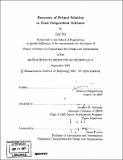Recovery of primal solution in dual subgradient schemes
Author(s)
Ma, Jing, S.M. Massachusetts Institute of Technology
DownloadFull printable version (3.896Mb)
Other Contributors
Massachusetts Institute of Technology. Computation for Design and Optimization Program.
Advisor
Asuman E. Ozdaglar.
Terms of use
Metadata
Show full item recordAbstract
In this thesis, we study primal solutions for general optimization problems. In particular, we employ the subgradient method to solve the Lagrangian dual of a convex constrained problem, and use a primal-averaging scheme to obtain near-optimal and near-feasible primal solutions. We numerically evaluate the performance of the scheme in the framework of Network Utility Maximization (NUM), which has recently drawn great research interest. Specifically for the NUM problems, which can have concave or nonconcave utility functions and linear constraints, we apply the dual-based decentralized subgradient method with averaging to estimate the rate allocation for individual users in a distributed manner, due to its decomposability structure. Unlike the existing literature on primal recovery schemes, we use a constant step-size rule in view of its simplicity and practical significance. Under the Slater condition, we develop a way to effectively reduce the amount of feasibility violation at the approximate primal solutions, namely, by increasing the value initial dual iterate; moreover, we extend the established convergence results in the convex case to the more general and realistic situation where the objective function is convex. In particular, we explore the asymptotical convergence properties of the averaging sequence, the tradeoffs involved in the selection of parameter values, the estimation of duality gap for particular functions, and the bounds for the amount of constraint violation and value of primal cost per iteration. Numerical experiments performed on NUM problems with both concave and nonconcave utility functions show that, the averaging scheme is more robust in providing near-optimal and near-feasible primal solutions, and it has consistently better performance than other schemes in most of the test instances.
Description
Thesis (S.M.)--Massachusetts Institute of Technology, Computation for Design and Optimization Program, 2007. Includes bibliographical references (p. 97-99).
Date issued
2007Department
Massachusetts Institute of Technology. Computation for Design and Optimization ProgramPublisher
Massachusetts Institute of Technology
Keywords
Computation for Design and Optimization Program.